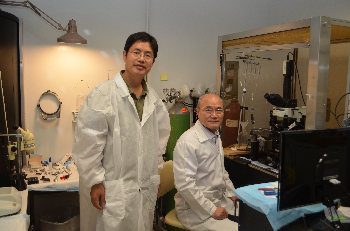
People who suffer from chronic pain that doesn’t respond to standard analgesic or opioid treatment may be closer to finding relief in the near future thanks to the pioneering work of Jin Mo Chung, professor of neuroscience and cell biology at UTMB.
Chung, who first came to UTMB as a postdoctoral fellow in 1977, has focused on solving the riddle of neuropathic pain throughout his career. After a short stint as an assistant professor at Seoul’s Yonsei University, he returned in 1981 to join the UTMB faculty. In 1992, he developed a model for studying chronically resistant pain that has been accepted worldwide as one of the most widely used standards in the field. The Chung Model uses a specific technique to prepare laboratory mice for research on how pain impulses behave in the spinal cord.
Chung’s research into the mechanisms of chronic pain, which is fundamentally different from acute pain, has two main areas of focus: the mechanisms of neuropathic pain and the mechanisms by which acupuncture relieves pain.
Neuropathic pain is different from other types of pain in that it originates from a malfunction of the nervous system. Normal pain-relief measures don’t work to relieve it. It often manifests in unusual ways. Light touch, for example, can cause intense discomfort, and tiny temperature changes may feel much larger. Caused by either accidental or disease-induced spinal damage, this kind of pain has proven nearly impossible to treat.
Chung’s most recent grant from the National Institutes of Health for $1.7 million, awarded in February, is allowing his research team to examine what his previous research had proven is an important mechanism that causes neuropathic pain.
Under normal conditions, pain impulses coming into the spinal cord are processed through two kinds of neurons, one that boosts their intensity and another that damps that intensity down — a kind of two-part volume knob for pain signals.
According to Chung’s data, nerve injury strengthens the effect of the “pain booster” nerve cells, while weakening that of the “pain damper” nerve cells. The result: even the smallest impulse comes out at full blast.
To figure out exactly how this process works, Chung is going to probe the electrical activity of the neurons in question; test whether two particular signaling molecules called free radicals are responsible for the neurons responding differently to the same pain impulse; and test the hypothesis that high levels of iron in the inhibitory neurons are involved in depressing their activity.
The goal is to piece together a coherent picture of the causes of chronic neuropathic pain; Chung believes that if his explanation proves out, it will open up a number of different avenues that could lead to treatments for the condition.